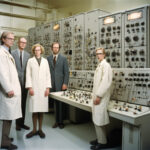Heaviest Proton Emitter: ‘Watermelon’ Atom Discovery Challenges Nuclear Models
Scientists at the Accelerator Laboratory of the University of Jyväskylä, Finland, have successfully measured the heaviest proton emitter to date, challenging existing nuclear models. The discovery of what scientists are calling the “watermelon” atom – due to its shape resembling that of the fruit – has opened up new possibilities in the field of nuclear physics.
This groundbreaking discovery has the potential to revolutionize our understanding of nuclear structure and behavior. The “watermelon” atom, with its unusually high number of protons, defies conventional wisdom and prompts scientists to reevaluate existing theories.
The implications of this discovery are far-reaching. Not only does it challenge our current understanding of nuclear physics, but it also paves the way for new advancements in technology and innovation. By pushing the boundaries of what we know about the building blocks of matter, scientists can unlock new potentials for energy production, medical applications, and beyond.
One of the key takeaways from this discovery is the importance of pushing the limits of scientific exploration. By venturing into uncharted territory and questioning established norms, researchers can make groundbreaking discoveries that have the power to shape the future of technology and society.
The “watermelon” atom serves as a reminder of the endless possibilities that exist within the realm of scientific inquiry. It underscores the importance of curiosity, perseverance, and collaboration in pushing the boundaries of human knowledge.
As scientists continue to unravel the mysteries of the universe, discoveries like the “watermelon” atom remind us of the sheer complexity and beauty of the natural world. By embracing the unknown and daring to challenge conventional wisdom, we pave the way for a future filled with innovation, discovery, and endless possibilities.
In conclusion, the discovery of the heaviest proton emitter, the “watermelon” atom, at the Accelerator Laboratory of the University of Jyväskylä, Finland, represents a significant milestone in the field of nuclear physics. By challenging existing models and pushing the boundaries of scientific exploration, researchers have opened up new avenues for discovery and innovation. The implications of this discovery are profound and have the potential to shape the future of technology and society.
innovation, technology, nuclearphysics, discovery, scientificexploration












